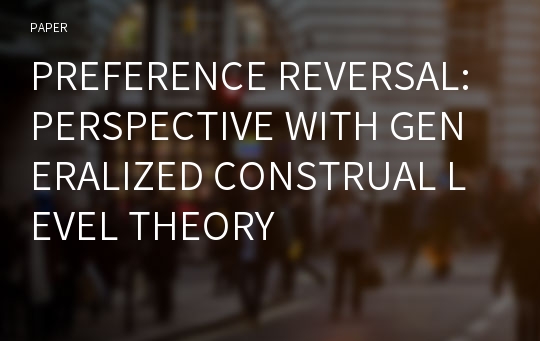PREFERENCE REVERSAL: PERSPECTIVE WITH GENERALIZED CONSTRUAL LEVEL THEORY
* 본 문서는 배포용으로 복사 및 편집이 불가합니다.
서지정보
ㆍ발행기관 : 글로벌지식마케팅경영학회(GFMC)
ㆍ수록지정보 : Global Marketing Conference
ㆍ저자명 : Makoto Abe, Takeshi Moriguchi, Akira Yashima
ㆍ저자명 : Makoto Abe, Takeshi Moriguchi, Akira Yashima
영어 초록
Preference Reversal and Discounting Everyone has experienced “procrastination”, for example, in the context of diet, quitting smoking, doing homework, etc. Despite a desirable goal in the long term perspective, people often divert their course for a minor gain of immediate future. “Marriage blue” is a typical example of such preference reversal along a temporal dimension. Wedding seems so desirable when it is planned. But as the wedding date approaches, one starts to focus minor issues in reality and becomes hesitant to get married. Such preference reversal along a time dimension has been considered as irrational behavior, and is often referred to as present bias or time inconsistency. Fields of Behavioral Economics and Behavioral Decision Theory try to explain the phenomenon using “discounting” along a time axis. Previous research has shown three well-known properties of “discounting over time”. (1) Invalidity of exponential discounting A discount rate is not constant, but decreases rapidly at first and later more gradually. (2) Amount effect A discount rate is larger for a small amount of money than for a large amount. (3) Sign effect A discount rate is larger for gain than for loss. The first property is used to explain “procrastination”. Exponential discounting, which assumes a constant discount rate over time, cannot explain the phenomenon because two utility curves, one for a large gain in further future and the other for a small gain in near future, never cross each other over time. On the other hand, hyperbolic discounting, with a declining discount rate over time, permits the crossing, thereby explaining “procrastination”. How about “marriage blue”? Unfortunately, neither exponential nor hyperbolic discounting can explain this phenomenon. By interpreting the initial desirability as gain and the minor issues as loss, the sign effect cannot explain the reversal, either. Perhaps more complicated discounting models are necessary. However, there exist many criticisms and complications for introducing complex discounting models. Construal level theory (CLT) with a minor twist can explain “marriage blue” in a simple manner, as will be shown. What is Construal Level Theory (CLT) ? CLT, which has been receiving increasing attention in Social Psychology and Consumer Behavior Studies, posits that people’s evaluation toward items and incidents differs by the psychological distance between oneself and the object. When the distance is close, people mentally construe the object in terms of low-level, detailed, and contextualized features. In contrast, when the distance is far, they construe the same object in terms of high-level, abstract, and stable characteristics. Such difference in mental construal leads to different evaluation and behavior, and thus preference reversal. Fiedler (2007) discusses different types of psychological distances, including temporal, spatial, social, certainty-related, informational, experiential, affective, and perspective distances. Using these general notions of “distance”, CLT becomes a powerful tool to explain various preference changes. Along social distance, choice of souvenir can differ whether it is for a work supervisor or for a family member. Along spatial distance, excitement toward bungee jump in the birth country of New Zealand when leaving airport in Tokyo can change to uneasiness when arriving at Oakland airport. Along experiential distance, an advanced medical treatment, which seems attractive from an outsider’s viewpoint, can change to anxiety for risk and side effect when you are the one to receive. Because “discounting” is used to explain preference reversal with varying time distance, it is rather natural to introduce this idea into CLT with appropriate adaptation. First, discounting applies not only to time distance but also to psychological distance in general. Then, the second property, “the difference in discount rates between low versus high amount of money” shall be translated to “the difference in discount rates between low versus high construal levels”. This conceptualization, which I refer to as GCLT, can explain “marriage blue” in a straightforward manner, when the high and low construal levels of wedding are interpreted, respectively, as the initial motive and the detail issues. Generalized Construal Level Theory (GCLT) Let us summarize the three propositions of the generalized construal level (GCLT). (1) [Generalization of distance] “Discounting” applies to psychological distances including time. (2) [Amount effect] Discount rate varies depending on the construal level: the higher the construal level, the smaller the discount rate. (3) [Sign effect] Discount rate is smaller for loss than for gain. The relationship between GCLT and CLT are as follows. 1) GCLT models the consequences of CLT using the idea of discounting. It does not mean GCLT can explain what CLT cannot. 2) GCLT introduces the notion of gain and loss into CLT. 3) While CLT usually discretizes the construal level (high vs. low), GCLT regards the construal level as continuous by nature. By modeling the input and output of CLT, GCLT bypasses the complicated and arguably controversial inner mechanism/process of human perception. GCLT can predict preference and behavior shift more easily as distance varies. There is no need to specify the functional form of discounting, such as exponential or hyperbolic. When the distance is limited to time and the construal level is limited to monetary amount, GCLT becomes consistent with the ordinary “discounting” of BDT, as it should. Empirical Studies The survey asks participants to choose one of two lotteries with the same expected return: one with a higher prize amount and the other with a higher winning probability. The reason for selecting a lottery is that attributes resulting in high and low construal levels are clearly defined and same for everyone. Previous research found that, in lottery choices, prize amount and winning probability lead to high and low construal levels, respectively. In other context, it is often ambiguous what attributes result in high and low construals. Moreover, such attributes can differ by people. We investigate how lottery choice changes when the psychological distance with the subject varies. We manipulate time distance through a lottery whose outcome is announced either tomorrow (short) or one month later (longer). We manipulate social distance through a lottery which is purchased either for yourself (short) or for a prize in a party at work (long). Proposition 1 The survey asks a respondent to choose either Lottery A or B, both of which have the same expected winning outcome of 1,000 yen. A half of the sample are asked to consider two cases of time distance (tomorrow and one month later), and the other half are asked to consider two cases of social distance (for yourself and for a prize in a party at work). The design is a within-sample study. The paired McNemar test is conducted to statistically check whether the proportion of respondents valuing prize amount (high construal) over winning probability (low construal) varies by distance. The result confirms the prediction by CLT, in which, for both time and social distances, respondents’ construal levels are higher when the distance is far and vice versa. Proposition 2 A respondent is asked to choose either Lottery A or B when Lottery R, an originally intended for purchase, is unavailable. Both Lotteries A and B have the same gain or loss in expected outcome of 1,000 yen. The difference is whether the gain or loss is due to the change in the prize amount or the winning probability. A half of the sample are asked to respond to two cases of time distance (tomorrow and one month later), and the other half are asked to respond to two cases of social distance (for yourself and for a prize in a party at work). Again, the design is a within-sample study. The paired McNemar test is conducted to statistically check whether the proportion of respondents valuing prize amount (high construal) over winning probability (low construal) varies by distance. The result shows that, for social distance, the respondents’ construal levels are higher when the distance is far and vice versa, under both gain and loss. It implies higher discount rate for a low construal level. For time distance manipulation, however, changing distance did not result in the construal level change under either gain or loss. Proposition 3 A respondent is asked to choose either Lottery A or B with the same expected winning outcome when the distance is far. The survey then asks whether she would switch from her initial choice when the distance becomes close. Switch from Lottery A to B trades off the loss in prize amount over the gain in winning probability. Likewise, switch from B to A trades off the gain in prize amount over the loss in winning probability. According to GCLT, switch is likely to occur from A to B but not in the other direction. This is because discounting of a high construal level (prize amount) in loss is small whereas discounting of a low construal level (winning probability) in gain is large, the net of the loss and the gain is likely to result in sign reversal as the distance becomes close. The chi-square test is conducted to statistically check whether the proportions of respondents switching from A and from B are the same. The result shows that, for both time and social distances, there are more switches from A to B than from B to A as the distance becomes close, thereby supporting Proposition 3. Conclusions Using two samples, students and web users, the survey study largely supports the three propositions of GCLT. The only exception is the amount effect in time distance. Our study could not confirm it using neither students nor web users.참고 자료
없음"Global Marketing Conference"의 다른 논문
 THE ROLES OF GREEN PACKAGING IN UGLY FOOD PURCHASE INTE..22페이지
THE ROLES OF GREEN PACKAGING IN UGLY FOOD PURCHASE INTE..22페이지 THE IMPACT OF INDUCED AWE ON ETHICAL TOURIST BEHAVIORS5페이지
THE IMPACT OF INDUCED AWE ON ETHICAL TOURIST BEHAVIORS5페이지 A BIBLIOMETRIC ANALYSIS OF SPIRITUAL TOURISM RESEARCH15페이지
A BIBLIOMETRIC ANALYSIS OF SPIRITUAL TOURISM RESEARCH15페이지 SOCIAL NETWORK ANALYSIS AND RESPONSE TIME TESTING: CONS..11페이지
SOCIAL NETWORK ANALYSIS AND RESPONSE TIME TESTING: CONS..11페이지 THE EFFECTS OF PARA-SOCIAL INTERACTION ON ONLINE CELEBR..3페이지
THE EFFECTS OF PARA-SOCIAL INTERACTION ON ONLINE CELEBR..3페이지 THE INFLUENCE OF OPINION LEADERS ON DAILY DEALS USER’S ..3페이지
THE INFLUENCE OF OPINION LEADERS ON DAILY DEALS USER’S ..3페이지 HOW IMMERSIVE RETAILING AFFECTS CONSUMERS’ URGE TO BUY:..6페이지
HOW IMMERSIVE RETAILING AFFECTS CONSUMERS’ URGE TO BUY:..6페이지 KEY TO SUPERSTARDOM IN A GLOBALISED MARKET: THE ROLE OF..6페이지
KEY TO SUPERSTARDOM IN A GLOBALISED MARKET: THE ROLE OF..6페이지 A POST-PANDEMIC LOOK AT TOURISTS’ PERCEIVED COOLNESS OF..4페이지
A POST-PANDEMIC LOOK AT TOURISTS’ PERCEIVED COOLNESS OF..4페이지 EXTRACTING OFFLINE RETAIL SHOPPING PATTERNS: OLLABORATI..5페이지
EXTRACTING OFFLINE RETAIL SHOPPING PATTERNS: OLLABORATI..5페이지


















